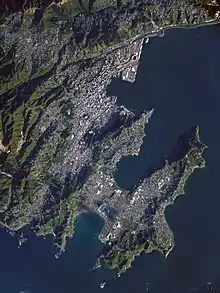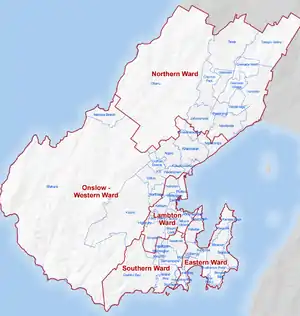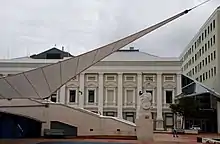Wellington City Council
Wellington City Council is a territorial authority in New Zealand, governing the country's capital city, and de facto second-largest city (if the commonly considered parts of Wellington, the Upper Hutt, Porirua, Lower Hutt and often the Kapiti Coast, are taken into account; these, however have independent councils rather than a supercity governance like Auckland, and so Wellington City is legally only third-largest city by population, behind Auckland and Christchurch). It consists of the central historic town and certain additional areas within the Wellington metropolitan area, extending as far north as Linden and covering rural areas such as Mākara and Ohariu. The city adjoins Porirua in the north and Hutt City in the north-east. It is one of nine territorial authorities in the Wellington Region.
Wellington City Council | |
|---|---|
 | |
 | |
| Type | |
| Type | |
| Leadership | |
Deputy Mayor | Sarah Free |
| Structure | |
| Seats | 15[lower-alpha 1] |
 | |
Political groups |
|
| Elections | |
| STV | |
Last election | 12 October 2019 |
Next election | 2022 |
| Meeting place | |
.JPG.webp) | |
| Wellington Town Hall Wakefield Street Wellington | |
| Website | |
| wellington.govt.nz/ | |
| Footnotes | |
| |

Wellington attained city status in 1886. The settlement had become the colonial capital and seat of government by 1865, replacing Auckland. Parliament officially sat in Wellington for the first time on 26 July 1865. During the last half of the nineteenth century, Wellington grew rapidly from 7,460 residents in 1867 to 49,344 by the end of the century.[1]
The council represents a population of 216,200 as of June 2020[2] and consists of a mayor and fourteen councillors elected from five wards (Northern, Onslow-Western, Lambton, Eastern, Southern).[n 1][3] It administers public works, sanitation, land use and building consents, among other local services. The council has used the marketing slogan "Absolutely Positively Wellington" in an official capacity since the early 1990s.[4]
Council
All councillors are members of Council, the Strategy and Policy Committee, and the Annual Plan/Long Term Plan Committee.[5]
Mayor
One mayor is elected at large from the entire Wellington City district.
| Name | Affiliation (if any) | First elected | Responsibilities | |
|---|---|---|---|---|
| Andy Foster | Independent | 2019 |
|
Eastern Ward
The Eastern ward returns three councillors to the Wellington City Council.
| Name | Affiliation (if any) | First elected | Responsibilities | |
|---|---|---|---|---|
| Sarah Free | Greens | 2013 |
| |
| Teri O'Neill | Labour | 2019 |
| |
| Sean Rush | The Wellington Party | 2019 |
|
Lambton Ward
The Lambton ward returns three councillors to the Wellington City Council.
| Name | Affiliation (if any) | First elected | Responsibilities | |
|---|---|---|---|---|
| Iona Pannett | Greens | 2007 |
| |
| Nicola Young | Independent | 2013 |
| |
| Tamatha Paul | Independent | 2019 |
|
Northern Ward
The Northern ward returns three councillors to the Wellington City Council.
| Name | Affiliation (if any) | First elected | Responsibilities | |
|---|---|---|---|---|
| Jill Day[6] | Independent | 2016 |
| |
| Malcolm Sparrow | Independent | 2013 |
| |
| Jenny Condie | Independent | 2019 |
|
Onslow-Western Ward
The Onslow-Western ward returns three councillors to the Wellington City Council.
| Name | Affiliation (if any) | First elected | Responsibilities | |
|---|---|---|---|---|
| Diane Calvert | Independent | 2016 |
| |
| Simon Woolf | Independent | 2013 |
| |
| Rebecca Matthews | Labour | 2019 |
|
Southern Ward
The Southern ward is the only ward that returns two councillors to the Wellington City Council (all others returning three).
| Name | Affiliation (if any) | First elected | Responsibilities | |
|---|---|---|---|---|
| Fleur Fitzsimons | Labour | 2017 |
| |
| Laurie Foon | Greens | 2019 |
|
Coat of arms

The City of Wellington has a Coat of Arms. The Blazon is;
- Arms: Quarterly Gules and Azure, a Cross Or between; In the first quarter a Fleece Or; in the second quarter on Water barry wavy proper in base a Lymphad sail furled pennon and flags flying Argent; in the third quarter a Garb Or; in the fourth quarter five Plates in Saltire Argent.
- Crest: On a Mural Crown Argent a Dolphin Naiant Azure, Mantled Gules.
- Supporters: On the dexter side a Lion gorged with a Collar and Chain reflexed over the back Or, and on the sinister side a Moa proper.
- Motto: Suprema a Situ.
Translation of the Blazon:
The shield is divided vertically and horizontally, quarter of which the first and fourth are red and the remaining pair are blue. A golden cross is placed over the entire shield centrally between these quarters. The top left quarter contains a golden fleece (usually depicted as a whole sheep with a band around its middle). The second quarter is depicted as a silver sailing ship (lymphad) with its sails furled as it would be in port but with its flags flying, placed on waves in their natural colour. The third quarter contains a golden wheat sheaf, and the fourth has five silver discs arranged in a saltire.
The mural crown (a crown depicted as if made of stonewalling) is common as a crest in city coats of arms. It is coloured silver, and from its top comes a swimming dolphin. Around the crest is mantling in red. The supporters on either side of the shield are a golden heraldic lion with a chained collar around its neck to the left, and a moa in its natural colouring on the right (the terms "sinister" and "dexter" relate to the shield from the holder's point of view, not the viewer's, thus dexter is the viewer's left and sinister is the viewer's right). The base on which the supporters stand is normally not emblazoned but is left to the artist to decide. The Motto may be translated as "Supreme by position".
Demographics
| Year | Pop. | ±% p.a. |
|---|---|---|
| 2006 | 179,466 | — |
| 2013 | 190,956 | +0.89% |
| 2018 | 202,737 | +1.20% |
| Source: [7] | ||
Wellington City had a population of 202,737 at the 2018 New Zealand census, an increase of 11,781 people (6.2%) since the 2013 census, and an increase of 23,271 people (13.0%) since the 2006 census. There were 74,841 households. There were 98,823 males and 103,911 females, giving a sex ratio of 0.95 males per female. Of the total population, 32,856 people (16.2%) were aged up to 15 years, 54,999 (27.1%) were 15 to 29, 93,669 (46.2%) were 30 to 64, and 21,213 (10.5%) were 65 or older. Figures may not add up to the total due to rounding.
Ethnicities were 74.1% European/Pākehā, 8.6% Māori, 5.1% Pacific peoples, 18.3% Asian, and 4.5% other ethnicities. People may identify with more than one ethnicity.
The percentage of people born overseas was 33.4, compared with 27.1% nationally.
Although some people objected to giving their religion, 53.2% had no religion, 31.4% were Christian, and 10.3% had other religions.
Of those at least 15 years old, 74,922 (44.1%) people had a bachelor or higher degree, and 12,690 (7.5%) people had no formal qualifications. The median income was $41,800. The employment status of those at least 15 was that 96,453 (56.8%) people were employed full-time, 24,738 (14.6%) were part-time, and 7,719 (4.5%) were unemployed.[7]
Suburbs
Wellington city has roughly 60 officially defined suburbs; one can group them by the wards used to elect the City Council. Some areas, while officially forming part of a larger suburb (or several suburbs), are considered by some to be separate communities. The officially defined suburbs include:

Northern Ward
- official: Churton Park; Glenside; Grenada Village; Grenada North; Horokiwi; Johnsonville; Newlands; Ohariu; Paparangi; Tawa; Takapu Valley; Woodridge
- informal: Greenacres; Redwood; Linden
Onslow-Western Ward
- official: Broadmeadows; Karori; Northland; Crofton Downs; Kaiwharawhara; Khandallah; Ngaio; Ngauranga; Mākara; Mākara Beach; Wadestown; Wilton.
- informal: Cashmere; Chartwell; Highland Park; Rangoon Heights; Te Kainga
Lambton Ward
- official: Brooklyn; Aro Valley; Kelburn; Mount Victoria; Oriental Bay; Te Aro; Thorndon; Highbury; Pipitea
Southern Ward
- official: Berhampore; Island Bay; Newtown; Vogeltown; Houghton Bay; Kingston; Mornington; Mount Cook; Ōwhiro Bay; Southgate
- informal: Kowhai Park
Eastern Ward
- official: Hataitai; Lyall Bay; Kilbirnie; Miramar; Seatoun; Breaker Bay; Karaka Bays; Maupuia; Melrose; Moa Point; Rongotai; Roseneath; Strathmore
- informal: Crawford; Seatoun Bays; Seatoun Heights; Miramar Heights; Strathmore Heights.
Communities of common interest
- Courtenay Place; Courtenay Quarter; Cuba Quarter; Lambton Quarter; The Waterfront Quarter
Positively Wellington Tourism, funded by the Wellington City Council, has designated the four inner-city "quarters" as marketing subdivisions to promote international and domestic tourism.
Educational facilities

Victoria University of Wellington, Wellington's oldest university, has its main campus in the hill suburb of Kelburn overlooking the centre of the city. It also has two downtown campuses and in the 2000s briefly had one in the western suburb of Karori after absorbing the former Wellington College of Education there. It originated as a constituent college of the University of New Zealand. The Senate of the University of New Zealand operated in Wellington until its dissolution in 1961.
A branch of Massey University is located in Wellington: it took over the site and some of the courses of the former Wellington Polytechnic. The campus is based at the former Dominion Museum, which has moved to Te Papa. The University of Otago also has a Wellington connection, as the Wellington School of Medicine and Health Sciences is a department of that university.
Wellington Institute of Technology serves Wellington and the neighbouring Hutt Valley. One of the largest polytechnics in the region, it dates from 1904.
Numerous primary and secondary educational institutions operate throughout the city, see List of schools in Wellington, New Zealand.
Wellington has a number of museums and galleries, including Te Papa, the City Gallery and the Museum of Wellington City & Sea. The Wellington Museums Trust runs the latter two, and other museums.
Sister-city relationships
- Sister cities[8]
.svg.png.webp) Sydney, Australia
Sydney, Australia.svg.png.webp) Canberra, Australia[9]
Canberra, Australia[9] Beijing, People's Republic of China
Beijing, People's Republic of China Xiamen, Fujian, People's Republic of China
Xiamen, Fujian, People's Republic of China Sakai, Osaka, Japan
Sakai, Osaka, Japan
- Historical sister cities[10]
- Friendly cities[11]
 Tianjin, People's Republic of China
Tianjin, People's Republic of China
History
The City of Wellington has subsumed independent boroughs including:
- Melrose (established 1888) in 1903
- Onslow (Khandallah/Ngaio) (established 1890) in 1919 (Wadestown had joined the city in 1906)
- Karori (established 1891) in 1920
- Miramar (established 1904) in 1921
- Johnsonville (a Town Board from 1908), in 1953
- Tawa (a Town district from 1951, then the Tawa Flat Borough Council from 1953) in 1989
Buildings

The Wellington City Council owns and until May 2019 operated from a complex on Wakefield Street, with various extensions each representing a distinctive architectural period. The complex incorporates the Wellington Town Hall which opened in 1904, with the most recent extension completed in 1991 alongside the Wellington Central Library.
The Wakefield Street complex has been cleared of back office functions, and since 28 May 2019 will be closed completely for repairs and earthquake strengthening. In the interim, most of the council's central office staff are located in commercial premises at 113 The Terrace, and the council's public service centre is at 12 Manners Street. Due to repairs also being needed to the Wellington Central Library, and Capital E, all of the civic buildings on Civic Square are closed, except for the City Gallery.
Use of pseudoscience
In December 2019, at the New Zealand Skeptics annual conference, the Wellington City Council and the Downer Group were co-awarded the Bent Spoon by NZ Skeptics for "showing the most egregious gullibility in 2019" for the contractor's use of water divining to find underground pipes.[12]
See also
References
- Footnotes
- Multiple councillors are elected to a ward using the single transferable vote (STV) system
- Citations
- "Wellington region. Page 8 – From town to city: 1865–1899". TeAra.govt.nz. Te Ara: The Encyclopedia of New Zealand. Retrieved 15 November 2016.
- "Population estimate tables - NZ.Stat". Statistics New Zealand. Retrieved 22 October 2020.
- "Overview – Elections 2010 – Wellington City Council". Retrieved 10 August 2010.
- Maclean, Chris (14 November 2012). "Branding Wellington". TeAra.govt.nz. Te Ara: The Encyclopedia of New Zealand. Retrieved 14 October 2013.
- "Committee Structure, Chairpersons and Membership" (PDF). Retrieved 9 November 2019.
- "Wellington City Council welcomes first female Maori councillor". Retrieved 8 November 2016.
- "Statistical area 1 dataset for 2018 Census". Statistics New Zealand. March 2020. Wellington City (047). 2018 Census place summary: Wellington City
- "Sister Cities – Overview". Wellington City Council. Retrieved 19 November 2014.
- "Canberra and Wellington Strengthen Ties". ACT Government. Retrieved 6 July 2016.
- "Historical Sister Cities". Wellington City Council. Retrieved 18 January 2014.
- "Friendly cities". Wellington City Council. Retrieved 18 January 2014.
- https://www.stuff.co.nz/dominion-post/news/117848225/wellington-city-council-wins-skeptics-award-after-contractor-divines-for-water
- A Complete Guide To Heraldry by A.C. Fox-Davies 1909.
External links
| Wikivoyage has a travel guide for Wellington City. |